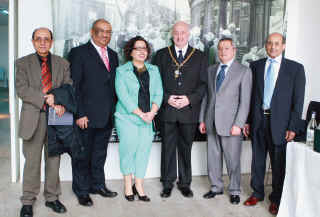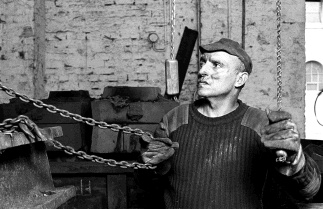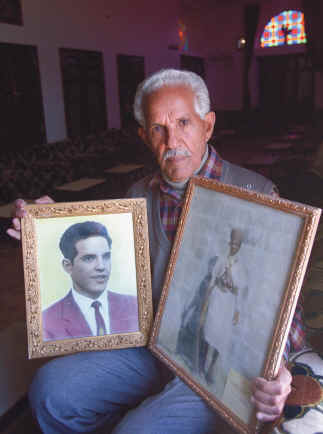From South Shields to
Sheffield: A photographic journey
by Rebecca Johnson
Yemenis in Britain were the focus of two exhibitions which I had the opportunity to visit in April this year. The first, entitled The Last of the Dictionary Men – Stories from South Shields’Yemeni Sailors, was held at the Baltic Centre for Contemporary Art, Gateshead. The reference to ‘Dictionary Men’ owes its inspiration to the Yemeni poet and intellectual, Abdullah al-Baradduni, who in a work published in 1995 wrote:
‘Our land is the dictionary of our people – this land of far horizons where the graves of our ancestors sleep, this earth trodden by processions of sons and sons of sons’
The early decades of the last century saw the arrival of several thousand Arab seaman at a number of British ports. The major concentrations were in Cardiff and South Shields. Most of these seamen came fromYemen and neighbouring parts of Britain’s Aden Protectorate, and were temporary migrants who returned to their home villages after a period of service on British ships. Over the years, however, an increasing number stayed on, forming the first significant Muslim communities to settle in Britain.
| |
|

|
From left to right: Alial-Thaur, Khaled Alyemany, Tina
Gharavi, Mayor of South Tyneside,
H. E. Mohamed Taha Mustafa and Abdo Mohamed Kaid (Chairman of the South Shields
Yemeni Community) Courtesy: Tony Griffiths
|
| |
|
 |
Abdo Mohamed Obeya, one of the 13 ‘Dictionary Men’. Courtesy:
Rebecca Johnson
|
| |
|
 |
Portraits of three ‘Dictionary Men’ taken by Youssef Nabil
|
After the Second World War, in which many Arab seamen lost their lives serving in the British Merchant Navy and Armed Forces, the decline of Britain’s shipping industry sharply reduced employment opportunities. The number of registeredYemeni seamen in South Shields dropped from several hundred in 1960 to under sixty in 1986, all of whom were by then aged over fifty. Meanwhile, intermarriage with the host society facilitated the assimilation of people of Yemeni descent into the wider community.
The rich but little known history of Yemenis in South Shields inspired film-makerTina Gharavi to undertake a series of video interviews with the ‘Dictionary Men’ for this exhibition. Forming a striking backdrop to the interviews were portraits by photographer Youssef Nabil of the thirteen Yemeni elders involved. These veterans of a long defunct occupation are the last surviving seamen from the first generation of Yemeni settlers in South Shields. The exhibition has thus played an invaluable part in recording for posterity their lives and memories. Accompanying the exhibition was a screening of Tina Gharavi’s moving documentary, The King of South Shields. This centred on the visit to Tyneside in 1977 by the champion boxer Muhammad Ali (Clay) and his wife to solemnise their marriage in the new mosque in Laygate – a familiar landmark with its white dome and twin minarets – and the inspirational impact which this visit had on local Muslim youth.
The launch of the exhibition was greatly enhanced by the presence of the ‘Dictionary Men’ themselves, some frailer than others but all happily basking in their hard-won celebrity! They came with members of their families, and to join three generations of Yemeni Tynesiders on that occasion was, for me, an unforgettable experience.
Sheffield was the venue for the other exhibition which I attended, entitled Coal, Frankincense and Myrrh. In the 1950s and 1960s a new influx of Yemenis into Britain found employment not in shipping but in heavy industry, especially in the steel and metal working plants in Sheffield and Birmingham. When the demand for seamen declined, someYemeni seafarers also moved to the Midlands as new employment opportunities in industry opened up there, and in this way forged a link between two phases of Yemeni migration to Britain. Many of the Yemenis who came to Sheffield worked in companies such as Firth Brown and Dunfold Hadfields. Years later, the 1994 civil war in Yemen brought a number of refugees to Sheffield seeking to join relations and friends already well established there.
The exhibition documented journeys made by Yemeni migrants, and their subsequent lives, and explored notions of ‘home’, identity and integration with the host society. At the heart of the exhibition were pictures taken over the past 25 years by photo-journalist Tim Smith, powerfully evoking the experience of an expatriate community through changing times, and highlighting aspects of the history which Yemen and Britain both share.
| |
|
 |
Yemeni worker at Thomas Clarke and Sons Foundry, Sheffield, 1984.
©Tim Smith, courtesy Museums Sheffield
|
| |
|
 |
Ali Mohamed Sa’id at his home in Thi Sura, UpperYafa’, in2007.
© Tim Smith, courtesy Museums Sheffield
|
| |
|
 |
Mohamed Ali Attia with pictures of himself as a young soldier in Yemen, and newly arrived in Britain (1958). After spending time as a
factory worker in a Warrington, he ran a grocery store in Liverpool before returning to Malah, Yemen, in1975.
© Tim Smith, courtesy Museums Sheffield
|
